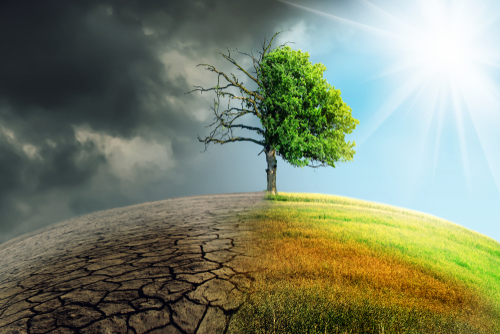The latest National Climate Assessment results have spurred waves of urgency to protect communities and the planet from possible climate risks. The report shows that global warming will impact low-income and high-risk communities the most as the situation grows dire to reform the electric grid and meet sustainability goals. Temperature increases are primarily driven by greenhouse gas emissions making reforms to the power grid and reaching sustainability goals of the utmost importance. For companies working in the space, a strong climate PR strategy can be essential to helping to push forward a mission for change. FischTank PR has extensive knowledge of the Cleantech, Sustainability, and Renewable Energy industries.
US Regions Will Suffer a Stunning Variety of Climate-Caused Disasters, Report Finds | Inside Climate News
“If there is one overarching message from the nation’s latest climate assessment, it is that nowhere will be spared.
Hotter temperatures are coming to every corner of the country, as are weather extremes. Many regions are experiencing more frequent, heavier rains, while others are seeing worsening drought. Some are getting both. Everywhere, these changes are translating into greater stresses on Americans’ health through worsening heatwaves, wildfires, hurricanes, floods and the psychological toll of mounting disasters.
The assessment highlights that these impacts are falling disproportionately on less wealthy communities and Black and Indigenous Americans and people of color.
On Tuesday, the Biden administration accompanied the report with an announcement of $6 billion in funding to help those efforts. The nation’s electric grid will get $3.9 billion to help protect it from climate impacts, while $2 billion will go toward community-driven projects on clean energy and climate resilience.”
‘The science is irrefutable’: US warming faster than global average, says report | Climate crisis | The Guardian
“While planet-heating US emissions have fallen since peaking in 2007, the reductions are still not enough to meet international targets to avert disastrous climate change, and without deeper cuts in carbon pollution “severe climate risks to the United States will continue to grow”, the report states.
Biden is responsible for “historic” investment in clean energy, via the Inflation Reduction Act, according to Ali Zaidi, Biden’s climate adviser, who pointed to the climate assessment’s endorsement of the economic, as well as health, benefits of switching to solar, wind and electric vehicles. “President Biden’s leadership on climate change is about turning crisis into opportunity, investing into the core of America,” Zaidi said.
Scientists who worked on the 32-chapter report, which touches on everything from climate change’s impact upon the oceans to agriculture to transportation to cultural practices, say that scientific confidence about the influence of global heating upon extreme weather and other phenomena has only strengthened since the last report in 2018.
“Climate change is here, it’s happening now, it’s unequivocal that humans are causing it,” said Adam Terando, a US Geological Survey scientist and report co-author.
Kristina Dahl, a climate scientist at the Union of Concerned Scientists, who was not involved in the publication, said the report is “the latest in a series of alarm bells and illustrates that the changes we’re living through are unprecedented in human history”.
Biden’s Fifth National Climate Assessment found these 5 key ways climate change is affecting the entire U.S. | CBS News
“Just last week, it was announced that data compiled by the European Union’s Copernicus Climate Change Service shows 2023 is “virtually certain” to be the hottest year ever observed on Earth.
Greenhouse gas emissions, which mostly come from the burning of fossil fuels such as oil and coal, are a primary driver of this temperature increase. And the most recent National Climate Assessment found that globally, those human-caused emissions have continued to increase worldwide despite long-standing warnings.
Whatever happens in one region will impact what happens in another, the report notes. This was seen earlier this year, when smoke from wildfires in Canada caused some U.S. cities to experience the worst air quality in the world. Climate change-induced agricultural stressors can also negatively influence global food supply chains and where humans are able to live.
Among the impacts are higher rates of heat-related illness and death, the spread of infectious diseases, worsening air quality, increases in pregnancy-related issues and higher rates of pulmonary, neurological and cardiovascular diseases, the department said. People of color, those with disabilities and those in the LGBTQ communities are among the most at-risk for these issues.”
US climate assessment lays out growing threats, opportunities as temperatures rise | Reuters
“Climate change is increasingly imposing costs on Americans, as prices rise for weather-related insurance or certain foods. Medical costs are also going up as more people struggle with climate consequences such as extreme heat, the report said.
Biden said he had seen firsthand the devastating toll of climate change when visiting areas hit by historic hurricanes, floods and wildfires, and said it was “foolish” for some Republicans to deny the impacts of climate change.
Last year, he said, natural disasters caused $178 billion in damages in the United States, often hitting the most vulnerable the hardest.
The assessment marks the fifth such report released by the U.S. government since 2000. It was peer-reviewed by the National Academies of Sciences, Engineering and Medicine.
For the first time, this year’s assessment includes a chapter on economics that illustrates how costly damages are distributed unevenly across society, often amplifying existing inequalities. It includes a new online tool that shows the impact in states, cities and counties.
The report also discusses national security risks of climate change, as countries compete for resources needed in the energy transition. Competition with China for minerals, for example, will likely escalate tensions between the two countries in coming years.
Climate migration, meanwhile, is expected to become a high-security risk by 2030 as people living in climate-vulnerable nations seek to cross the border into the United States for safety, the report says.”
Climate impacts in the U.S. are ‘far-reaching and worsening,’ federal report finds | The Washington Post
“Renewable energy has become widespread and cheap in recent years, dramatically reducing the electricity grid’s emissions. Farming practices are storing more planet-warming carbon in the soil. Waterside communities are preparing for higher floods by raising some homes, demolishing others and enhancing natural barriers. Through infrastructure legislation and the Inflation Reduction Act, Congress has approved an unprecedented amount of spending on efforts to make the nation more weather-ready and to speed its transition from fossil fuels.
Due in part to the legacy of racism and exclusionary housing practices, many minority and low-income people face the highest threat of inland flooding. Indigenous communities disproportionately face the loss of fisheries, reliable water and other resources.
“We know that these impacts exacerbate social inequities, including racial and gender-based disparities,” said Katharine Hayhoe, one of the report’s authors and chief scientist at the Nature Conservancy. “And we’re now recognizing that climate solutions must also be solutions for justice and equity.”
Hayhoe, who also worked on previous assessments, said researchers struggled years ago to find case studies of U.S. climate adaptation, but no longer. “We were beating the bushes looking for examples of cities and states that were already adapting,” she said. “That is something that is a big difference [now].”
Despite such commitments, the nation remains largely unprepared for the significant changes that are unfolding and those that have yet to play out, said Kim Cobb, a Brown University climate scientist and director of the Institute at Brown for Environment and Society.
The best possible future will emerge, the report finds, only if the nation works collectively to confront a challenge unlike any faced by previous generations.”
The Toll of Climate Disasters Is Rising. But a U.S. Report Has Good News, Too. | NYT
“Mr. Biden said Tuesday that along with the report, his administration created an online tool to enable people to see the impacts of climate change in their city and state.
The report issued Tuesday points out that cost-effective tools and technologies to significantly reduce America’s contribution to global warming already exist. U.S. emissions of heat-trapping gases fell by 12 percent between 2005 and 2019 as the country has shifted from coal toward natural gas and renewable sources. And options are increasing for electrifying energy use, reducing energy demand and protecting natural carbon sinks like forests and wetlands, the report says.
Such metrics do not, however, capture the full effects of warming on less-tangible things Americans value, including human health, ecosystems, trades like fishing that are passed down over generations and even recreational activities such as skiing, camping and other outdoor pastimes that wildfire smoke and scorching heat increasingly lace with peril. “Nonmarket effects of climate change in many cases are some of the largest,” Dr. Hsiang said.
The assessment cites a few programs in California and Florida that have tried to plan for climate adaptation across city and county lines. Yet when not properly designed and monitored, adaptation efforts can lead to unintended side effects, said Katharine J. Mach, an environmental scientist at the University of Miami who contributed to the report. “In some cases, we may be working well on climate but creating other issues,” she said.
Disaster relief, for example, goes disproportionately to cities and towns, which could be exacerbating urban-rural disparities, Dr. Mach said. Federal buyouts of homes in vulnerable places have occurred disproportionately in wealthy counties, largely because agencies there can better navigate the bureaucratic requirements.
Dr. Davis expressed optimism that the hurdles could be navigated. The assessment cites analyses showing that clean energy and related industries can create enough jobs to offset declines in fossil-fuel employment. Switching to zero-carbon energy could reduce air pollution enough to prevent 200,000 to 2 million deaths by 2050, the report says.
“It’s not all bad trade-offs,” Dr. Davis said.”
Every region of the country is taking climate action. Here’s how. | Grist
“As the crisis has intensified, so have efforts to mitigate it. States, cities, businesses, and organizations across the country are taking increasingly large steps to reduce emissions — and those efforts are aided by the falling costs of renewable energy and other decarbonizing technologies.
Northeast
Connecticut, Delaware, Maine, Maryland, Massachusetts, New Hampshire, New Jersey, New York, Pennsylvania, Rhode Island, Vermont, Washington, D.C., West Virginia
Large and deadly storms, like Superstorm Sandy in 2012, have hastened efforts to bolster infrastructure in the Northeast in preparation for the more severe impacts of climate change. The region is also home to a cadre of progressive governors who have championed climate action.
“Eight states in the region (Maine, New Hampshire, Vermont, Massachusetts, Rhode Island, Connecticut, New York, and New Jersey) have laws requiring emissions reductions of at least 80 percent by 2050,” the report says, a goal these states aim to achieve by restricting the use of fossil fuels and encouraging the growth of green technologies.
Some of the most aggressive efforts to adapt to climate change are being led by the region’s federally recognized tribes. Last year, the Mi’kmaq Nation in northern Maine approved the Thirteen Moons Climate Adaptation Plan, which highlights the dangers warming poses to the traditional Mi’kmaq way of life.
While most non-Indigenous populations across the U.S. have been slow to acknowledge the threats a changing climate poses to daily life, the Mi’kmaq Nation is clear-eyed about which traditions can be preserved and which must be adapted.”
Biden ‘just getting started’ on climate action in response to major new report | ABC News
“Biden said climate change was a recurring theme in the Bipartisan Infrastructure Law, Inflation Reduction Act and the CHIPS Act. The White House also announced more than $6 billion in what it said was an effort to “strengthen climate resilience” on Tuesday, a large amount of which comes from the Bipartisan Infrastructure Law and the Inflation Reduction Act, according to a White House fact sheet.
The funding includes $3.9 billion to “strengthen and modernize” the electric grid, $2 billion in EPA grants for community clean energy and environmental justice projects, $300 million from FEMA for communities impacted by catastrophic flooding, and $100 million in grants to support drought resilience in Western states.
“We’re just getting started. … All told, my investing in America Agenda and those bold climate laws are the most ambitious in American history,” he said.
The report issues a stark warning that extreme events and harmful impacts of climate change that Americans are already experiencing, such as heat waves, wildfires, and extreme rainfall, will worsen as temperatures continue to rise. But it also found that while climate action is still incremental, there are areas for economic opportunity in the United States, including clean energy.”
US climate report offers dire outlook, with temperatures expected to cross key thresholds | The Hill
“The report listed consequences all around the country, noting that at this level of warming, the Southeast will see six more days over 100 degrees Fahrenheit each year and the Midwest will see 10 more days over 95 degrees.
It said that further warming will create more risks for the nation’s water supply, food security, infrastructure, health, ecosystems and economy.
For example, climate change is expected to make food less available and more expensive as high temperatures reduce crop yields and introduce disease, while droughts and wildfires may threaten water supplies and put more heat stress on livestock. It also said that changes in the timing of streams that come from melting snow are expected to disrupt water infrastructure and hydropower to meet the region’s needs.
Dave White, lead author of the report’s Southwest regional chapter, pointed out that declines in water availability in the area worsened by climate change, could reverberate well beyond the borders of Arizona, New Mexico, Utah, Colorado, Nevada and California.”
Environmental Justice a Key Theme Throughout Biden’s National Climate Assessment| Inside Climate News
“It’s the first time a National Climate Assessment, the federal climate report mandated by Congress under the Global Change Research Act of 1990, has placed such a heavy emphasis on the concept of environmental justice..
The report’s sharp focus on environmental justice issues surprised Maria Lopez-Nunez, deputy director of the New Jersey-based social justice advocacy group Ironbound Community Corporation in Newark, and a member of the White House Environmental Justice Advisory Council. Lopez-Nunez, who lives in a neighborhood surrounded by heavy industry, sewage plants and the state’s biggest shipping hub, said she had largely written off past climate assessments because she believed they failed to properly acknowledge the reality of neighborhoods like hers.
“I used to see the smokestacks with the fire and everything,” said Heath, 58, an organizer for the nonprofit Philly Thrive who has asthma, and remembers watching the pollution’s impact on her mother, a community organizer, who died of breast cancer in 2013 at the age of 80. “All kinds of chemicals are in the air and we breathe it in every day. We’ve been breathing it since the first factory and the first car was built.”
The plight of families like Heath’s is a major theme throughout the Fifth National Climate Assessment.
Robert Dubrow, director of the Yale Center on Climate Change and Health, Environmental Health Sciences, said he believes that documenting these adverse mental health outcomes after weather events could move the needle and accelerate the kind of policy changes needed to address the ills of climate change.
The latter, the report suggests, should be a particular priority for those in fenceline communities like Crystal Heath.
“African Americans and individuals with low incomes face higher risks of death from climate-driven floods and air pollution compared to white people,” the assessment notes. “People of color are disproportionately exposed to greenhouse gas co-pollutants like small particulate matter and face adverse health impacts as a result.”
The new report is the first National Climate Assessment to trace such exposure to “housing discrimination and redlining”—the long-standing practice of denying people of color home loans in certain neighborhoods before the enactment of fair housing laws.”
***Guest post from FischTank PR interns: Veronica Riga and Bianca Roque ***
Want to learn more about Cleantech, Sustainability, Renewable Energy, and Climate PR?
FischTank PR works with top brands and companies in the Cleantech, Sustainability and Renewable Energy industries, helping them achieve various communications and public relations strategies designed to boost their business and promote the industry’s message. If you’re looking for a climate PR firm with great industry understanding and a results-oriented approach to media relations, please contact us at [email protected].




